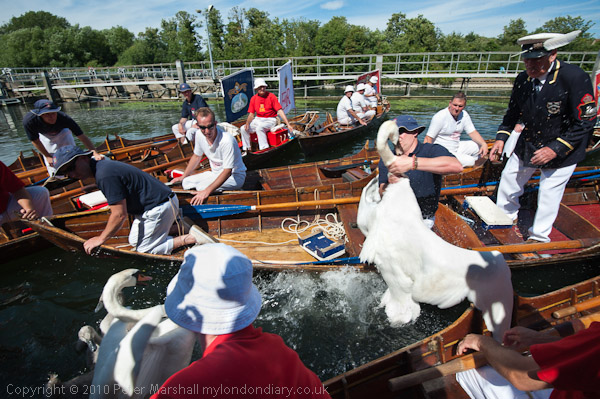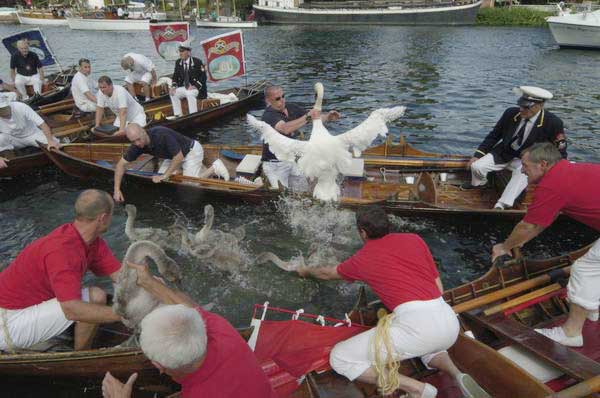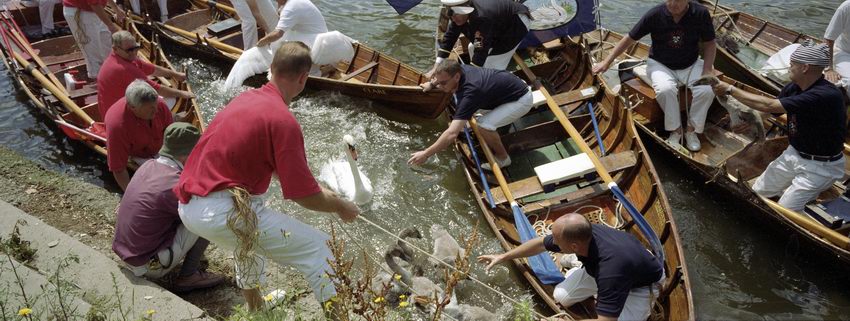I was in two minds over whether to go and photograph the Swan Uppers again this year. It’s a subject where I think I’ve probably more or less done all I can do over the last ten years, and which in some respects doesn’t change a great deal year to year. But it was a nice day and the river is only a five minute walk away, so I went along again – as you can see below and in many more pictures on My London Diary.

Swan upping 2010 – Nikon D700

Swan upping 2004 – taken on a Nikon D100
Photographically it’s very hard not to repeat – with small variations – what I’ve done before. And since I think I’ve had some good luck in the past those variations generally result in pictures that are not quite as good as some I’ve taken before – as you can see above.
It’s also an event which is getting just a little harder to photograph, not because of any real changes in the event but simply because interest in the event, and in particular press interest has increased. I think the first year I photographed it there were probably only around three or four other photographers present. Now it becomes virtually impossible to move at the times when you really need to be in exactly the right spot, and it isn’t quite predictable where the peak of the action will occur.
A couple of years ago there was some extra interest as it seemed likely that the Labour government would be tidying up some of our ancient laws and this might remove the rationale behind the upping – basically an annual census of swans born each year on the non-tidal River Thames between Sunbury and Abingdon, in which the year’s cygnets are shared between the sovereign and two City of London livery companies, the Dyers and the Vintners.
In the old days swans were a feature of royal banquets – and also until around 25 years ago those of the two companies (and by a special royal dispensation, at St John’s College Cambridge); it was a privilege rigorously protected against more plebeian tastes and catching one of these royal birds could get you sent to the Tower or transported; now you only risk a fine of up to £5000 and/or six months in jail under the Wildlife and Countryside Act, 1981. I’m told that properly cooked they can be delicious, though others are less keen (and the description that they are like a ‘fishy goose’ certainly doesn’t attract me.) Certainly it doesn’t seem worth the risk.
Perhaps the best coverage I’ve made of the event was on film, using a Leica M fitting Konica Hexar RF and the Hassleblad Xpan panoramic camera (made by Fuji) , which produces a 58x24mm negative on 35mm film. Although it was a camera I lusted after when it came out, I soon found using it with the normal 40mm lens a little disappointing.
With the 40mm you get roughly the same horizontal coverage as with a 28mm on the standard 35mm format, but of course a greatly reduced vertical coverage. You could get the same picture simply by cropping a 28mm image, although the area of the negative would then be less than 4/10 that of the XPan. To get the same quality you would need to shoot on 6×6 and crop, so the XPan did give you the advantage of using medium format but with handling (and choice of films and costs) of 35mm.

Swan Upping 2001 – Hasselblad XPan and 40mm lens
But what really transformed this camera for me was the 30mm lens, equivalent to around a 20mm across the image. It comes with its own accessory viewfinder giving a beautifully large and bright view- and with a visible spirit level – and needs a special filter to combat the vignetting which is inevitable with ultra-wide rectilinear lenses. It was wider than anything available for medium format and a superb quality lens that could normally be left wide-open.
It would I think be too expensive to produce a digital version of the Xpan, and the film version is only available second-hand, production having to be abandoned because of environmental legislation that banned the method used to make its circuit boards. The camera sold better in the UK than in other countries, but sales were not high enough to justify redesigning board to get round this.
At least one reviewer has stated that with the 30mm lens it is essential to use the camera on a tripod. I don’t think I ever tried that, but it certainly wasn’t a lens for low light work, with the maximum aperture of f5.6 reduced by a stop and a half by the filter. But in good light it was easy enough to use hand-held, and given the focal length and aperture you seldom needed to use the normal range-finder window to focus. The automatic exposure was generally pretty accurate and in good light it was really a point and shoot camera, but as the auto-wind had to cope with almost twice the normal movement it was just a little slow to wind on for rapid action – so then I switched to the Hexar RF (the first modern ‘Leica’) which gave 2.5 fps.